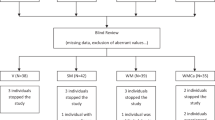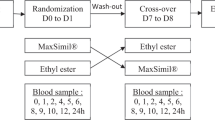Abstract
Objective:
The aim of this study was to investigate whether a plant sterol mixture would reduce serum cholesterol when added to low fat dairy products in subjects with hypercholesterolaemia, and to examine the effects of the mixture on the serum plant sterol and fat-soluble vitamin levels.
Design:
A parallel, double-blind study.
Setting:
The study was performed in three different locations in Finland.
Subjects:
In total, 164 mildly or moderately hypercholesterolaemic subjects participated in the study.
Methods:
The subjects were randomly divided into two groups: a plant sterol group and a control group. The subjects consumed the products for 6 weeks after a 3-week run-in period. The targeted plant sterol intake was 2 g/day in the sterol group.
Results:
During the treatment period, there was a 6.5% reduction in serum total cholesterol in the sterol group while no change was observed in the control group (P<0.0005). Serum low-density lipoprotein (LDL) cholesterol was reduced by 10.4% in the sterol group and by 0.6% in the control group (P<0.00005). There was no change during the trial in serum high-density lipoprotein (HDL) cholesterol or triacylglycerol concentrations. The HDL/LDL cholesterol ratio increased by 16.1% in the sterol group and by 4.3% in the control group (P=0.0001). Serum plant sterol levels increased significantly (P=0.0001) in the sterol group. None of the fat-soluble vitamin levels decreased significantly when changes in serum total cholesterol were taken into account. The hypocholesterolaemic effect of sterol administration was not influenced by apolipoprotein E phenotype.
Conclusions:
Yoghurt, low-fat hard cheese and low-fat fresh cheese enriched with a plant sterol mixture reduced serum cholesterol in hypercholesterolaemic subjects and no adverse effects were noted in the dietary control of hypercholesterolaemia.
This is a preview of subscription content, access via your institution
Access options
Subscribe to this journal
Receive 12 print issues and online access
$259.00 per year
only $21.58 per issue
Buy this article
- Purchase on Springer Link
- Instant access to full article PDF
Prices may be subject to local taxes which are calculated during checkout

Similar content being viewed by others
References
Berger A, Jones PJH, Abumweis SS (2004). Plant sterols: factors affecting their efficacy and safety as functional food ingredients. Lip Health Dis 3, 1–19.
Chuang CH, Trosclair G, Lopez-S A (1994). Adaptation of a carotenoid procedure to analyze carotenoids, retinol and alpha-tocopherol simultaneously. J Liquid Chromatogr 17, 3613–3622.
Clifton PM, Noakes M, Sullivan D, Erichsen N, Ross D, Annison G et al. (2004). Cholesterol-lowering effects of plant sterol esters differ in milk, yoghurt, bread and cereal. Eur J Clin Nutr 58, 503–509.
Colgan HA, Floyd S, Noone EJ, Gibley MJ, Roche HM (2004). Increased intake of fruit and vegetables and a low-fat diet, with and without low-fat plant sterol-enriched spread consumption: effects on plasma lipoprotein and carotenoid metabolism. J Hum Nutr Dietet 17, 561–569.
Friedewald WT, Levy RI, Fredrickson DS (1972). Estimation of the concentration of low-density lipoprotein cholesterol in plasma, without use of the preparative ultracentrifuge. Clin Chem 18, 499–502.
Gylling HK, Puska P, Vartiainen E, Miettinen TA (1999). Retinol, vitamin D, carotenes and alpha tocopherol in serum of a moderately hypercholesterolaemic population consuming sitostanol margarine. Athersclerosis 145, 279–285.
Gylling H, Radhakrishnan R, Miettinen TA (1997). Reduction of serum cholesterol in postmenopausal women with previous myocardial infarction and cholesterol malabsorption induced by dietary sitostanol ester margarine: women and dietary sitostanol. Circulation 96, 4226–4231.
Havekes LM, de Knijff P, Beisiegel U, Havinga J, Smit M, Klasen E (1987). A rapid micromethod for apolipoprotein E phenotyping directly in serum. J Lipid Res 28, 455–463.
Hallikainen MA, Sarkkinen ES, Uusitupa MIJ (1999). Effects of low-fat stanol ester enriched margarines on concentrations of serum carotenoids in subjects with elevated serum cholesterol concentration. Eur J Clin Nutr 54, 966–969.
Heinemann T, Kullak-Ublick GA, Pietruck B, von Bergmann K (1991). Mechanisms of action of plant sterols on inhibition of cholesterol absorption. Comparison of sitosterol and sitostanol. Eur J Clin Pharmacol 40, S59–S63.
Hendriks HF, Weststrate JA, van Vliet T, Meijer GW (1999). Spreads enriched with three different levels of vegetable oil sterols and the degree of cholesterol lowering in normocholesterolaemic and mildly hypercholesterolaemic subjects. Eur J Clin Nutr 53, 319–327.
Jones PJ, MacDougall DE, Ntanios F, Vanstone CA (1997). Dietary phytosterols as cholesterol-lowering agents in humans. Can J Physiol Pharmacol 75, 217–227.
Koivu-Tikkanen TJ, Ollilainen V, Piironen VI (2000). Determination of phylloquinone and menaquinones in animal products with fluorescence detection after postcolumn reduction with metallic zinc. J Agric Food Chem 48, 6325–6331.
Koivu-Tikkanen TJ, Salo-Väänänen PP, Ollilainen V, Piironen VI (2005). Simultaneous extraction and purification procedure of plasma samples for HPLC determination of vitamins K1, E and A. Submitted.
Law M (2000). Plant sterol and stanol margarines and health. BMJ 320, 861–864.
Lowry OH, Rosenbrough NY, Farr AL, Randall RJ (1951). Protein measurement with the folin phenol reagent. J Biol Chem 50, 172–182.
Mensink RP, Ebbing S, Lindbout M, Plat J, van Heugten MMA (2002). Effects of plant stanol esters supplied in low-fat yoghurt on serum lipids and lipoproteins, non-cholesterol sterols and fat soluble antioxidant concentrations. Atherosclerosis 160, 205–213.
Morton G, Lee S, Buss D, Lawrence P (1995). Intakes and major dietary sources of cholesterol and phytosterols in the British diet. J Human Nutr Dietet 8, 429–440.
Neil HA, Meijer GW, Roe LS (2001). Randomised controlled trial of use by hypercholesterolaemic patients of a vegetable oil sterol-enriched fat spread. Atherosclerosis 156, 329–337.
Nestel P, Cehun M, Pomeroy S, Abbey M, Weldon G (2001). Cholesterol-lowering effects of plant sterol esters and non-esterified stanols in margarine, butter and low-fat foods. Eur J Clin Nutr 55, 1084–1090.
Nissinen M, Gylling H, Vuoristo M, Miettinen TA (2002). Micellar distribution of cholesterol and phytosterols after duodenal plant stanol ester infusion. Am J Physiol Gastrointest Liver Physiol 282, G1009–G1015.
Norman CW, Wong MD (2001). The beneficial effects of plant sterols on serum cholesterol. Can J Cardiol 17, 715–721.
Ovaskainen M-L, Valsta L, Lauronen J (1996). The compilation of food analysis values as a database for dietary studies- the Finnish experience. Food Chem 57, 133–136.
Pelletier X, Belbraouet S, Mirabel D, Mordret F, Perrin JL, Pages X et al. (1995). A diet moderately enriched in phytosterols lowers plasma cholesterol concentrations in normocholesterolemic humans. Ann Nutr Metab 39, 291–295.
Phillips KM, Ruggio DM, Bailey JA (1999). Precise quantitative determination of phytosterols, stanols, and cholesterol metabolites in human serum by capillary gas-liquid chromatography. J Chromatogr B Biomed Sci Appl 732, 17–29.
Pietinen P, Hartman AM, Haapa E, Rasanen L, Haapakoski J, Palmgren J et al. (1988). Reproducibility and validity of dietary assessment instruments. I. A self-administered food use questionnaire with a portion size picture booklet. Am J Epidemiol 128, 655–666.
Pouteau EB, Monnard IE, Piguet-Welsch C, Groux MJ, Sagalowicz L, Berger A (2003). Non-esterified plant sterols solubilized in low fat milks inhibit cholesterol absorption – a stable isotope douple-blind crossover study. Eur J Nutr 42, 154–164.
Raeini-Sarjaz M, Ntanios FY, Vanstone CA, Jones PJH (2002). No changes in serum fat-soluble vitamin and carotenoid concentrations with the intake of plant sterol/stanol esters in the context of a controlled diet. Metabolism 51, 652–656.
Richelle M, Enslen M, Hager C, Groux M, Tavazzi I, Godin J-P et al. (2004). Both free and esterified plant sterols reduce cholesterol absorption and the availability of β-carotene and α-tocopherol in normocholesterolemic humans. Am J Clin Nutr 80, 171–177.
Sugiuchi H, Uji Y, Okabe H, Irie T, Uekama K, Kayahara N et al. (1995). Direct measurement of high-density lipoprotein cholesterol in serum with polyethylene glycol-modified enzymes and sulfated alpha-cyclodextrin. Clin Chem 41, 717–723.
Thomsen AB, Hansen HB, Christiansen C, Green H, Berger A (2004). Effect of free plant sterols in low-fat milk on serum lipid profile in hypercholesterolemic subjects. Eur J Clin Nutr 58, 860–870.
Tikkanen MJ, Hogstrom P, Tuomilehto J, Keinanen-Kiukaanniemi S, Sundvall J, Karppanen H (2001). Effect of a diet based on low-fat foods enriched with nonesterified plant sterols and mineral nutrients on serum cholesterol. Am J Cardiol 88, 1157–1162.
Weststrate JA, Meijer GW (1998). Plant sterol-enriched margarines and reduction of plasma total- and LDL-cholesterol concentrations in normocholesterolaemic and mildly hypercholesterolaemic subjects. Eur J Clin Nutr 52, 334–343.
Volpe R, Niittynen L, Korpela R, Sirtori C, Bucci A, Fraone N et al. (2001). Effects of yoghurt enriched with plant sterols on serum lipids in patients with moderate hypercholesterolaemia. Br J Nutr 86, 233–239.
Acknowledgements
This study was partly supported by TEKES. We are grateful for the assistance of Pirjo Härkönen RN, Eija Lahdensuo RN, Pirjo Hilli RN, Arja Putila RN, Satu Myller RN, Anne Vänskä RN, Virpi Salminen MSc, Marjo Mannelin MSc, Terhi Hakala Ms and Kirsti Räsänen Ms for their contributions to this study. We are also grateful to Mimi Ponsonby, MA, for correcting the English and to Tiina Jauhiainen MSc for the assistance in the preparation of the manuscript. We thank Valio Ltd and the Foundation for Nutrition Research for the study products and for financial support. The test products were provided by Valio Ltd.
Author information
Authors and Affiliations
Corresponding author
Additional information
Guarantor: R Korpela.
Contributors: RK helped in the initiation of the study and writing of the manuscript, JT was responsible for the study design, supervision of the clinical study in all four areas and the writing of the manuscript, PH for coordinating the clinical study, the statistical analysis and the writing of the manuscript, LS assisted in the writing of the manuscript, VP and PS-V performed fat-soluble vitamin analysis, JT performed sterol analysis, CL-A, MK and TO performed 25(OH) vitamin D analysis, JS and SV performed cholesterol analysis, and MJT was responsible for the safety aspects, the LDL oxidation analysis and the writing of the manuscript.
Rights and permissions
About this article
Cite this article
Korpela, R., Tuomilehto, J., Högström, P. et al. Safety aspects and cholesterol-lowering efficacy of low fat dairy products containing plant sterols. Eur J Clin Nutr 60, 633–642 (2006). https://doi.org/10.1038/sj.ejcn.1602362
Received:
Revised:
Accepted:
Published:
Issue Date:
DOI: https://doi.org/10.1038/sj.ejcn.1602362
Keywords
This article is cited by
-
Phytosterol compositions of enriched products influence their cholesterol-lowering efficacy: a meta-analysis of randomized controlled trials
European Journal of Clinical Nutrition (2019)
-
Plasma fat-soluble vitamin and carotenoid concentrations after plant sterol and plant stanol consumption: a meta-analysis of randomized controlled trials
European Journal of Nutrition (2017)
-
Factors influencing the absorption of vitamin D in GIT: an overview
Journal of Food Science and Technology (2017)
-
Effect of phytosterols and inulin-enriched soymilk on LDL-cholesterol in Thai subjects: a double-blinded randomized controlled trial
Lipids in Health and Disease (2015)
-
Consumption of a dietary portfolio of cholesterol lowering foods improves blood lipids without affecting concentrations of fat soluble compounds
Nutrition Journal (2014)



